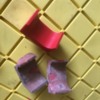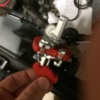I switched the pads on my old EMPI Camber Compensator; found replacements at CIP1.com. Asking the brain trust here; what exactly happens to these pads for them to look like this?
Replies sorted oldest to newest
There are chemical components in urethane that evaporate or change with age.... The urethane then "hardens" and is more prone to cracking and abrasion.... I have never understood how it made it's way into critical components on our cars.... Exposure to sunlight will normally accelerate the aging process.... It makes a great varnish, but thats about it....
I've never understood our hobby/industry's fascination with red urethane, especially it's continued use for many years for transaxle mounts and steering couplers. I know I shouldn't be- it's cheap to mold and work with and adds (what some people think is) a little bit of bling, so the VW crowd being the cheap a*sed idiots that they are, we get what we deserve I guess.
As has been said, with age the material always fatigues and tears, which while being a grand pain in the petootie replacing mounts every couple of years is just downright dangerous as a steering coupler. Al
I don’t like red urethane and whenever humanly possible I avoid it; especially the steering coupler and the rear torsion bar bushings. I try to use OEM rubber whenever I can but for this application this is the only alternative. I expect to have to do the same sometime with my front anti sway bar bushings. My car didn’t have one from the VS shop back in 2004 and, not knowing better, instead of sourcing a stock anti sway bar with the regular rubber bushings I went to my VW shop and got a Bugpack (now part of EMPI) 3/4” dia unit with the stainless steel clamps/ red urethane mounting kit. Live and learn. Ironically those don’t look bad as the compensator pads did, ironically you would think they are more exposed to the elements.
I just talked to an engineer friend of mine and he says it’s Chinese urethane adulterated with melanine to give it hardness.
Since the early '80s at least, urethane suspension components were touted for racing and spirited street use for just about every kind of car. Sway bar bushings, end links, strut bushings, control arm bushings—basically everything rubber on a suspension should be replaced with urethane to stiffen up the chassis for competition, according to all the experts at Car Craft Magazine, etc.
These days I'm not even sure this was ever true. Maybe if I was racing I'd learn for sure, but for driving on public roads with street tires over any distance...maybe the stock engineers knew something Car Craft (and its advertisers) didn't.
At any rate, the urethane-everywhere-edict doesn't hold in the air-cooled VW world because those urethane parts are (usually) made as cheaply as possible. I don't know if Impala's friend is exactly right on the details, but I know from experience that @ALB speaks the truth on this matter.
Agree absolutely. Rubber is available in many different degrees of hardness. Urethane has some good applications, as I've said before. If it's encapsulated, as it is for swaybar bushings I don't see the problem. A failed swaybar bushing shouldn't cause a fatal failure, just a clunking noise in the suspension. But in a shear application it's just a fools game.
A word of warning from my side: I needed a new steering coupler, and seeing that plain black rubber was the same price as the red racey urethane thingy, I opted for the latter. Progress on my build was (is) slow, so when I accidentally touched the mounted coupler a year later, it actually crumbled to pieces. Basically fully eliminating the coupling between steering box and column. When driving this would likely have resulted in more than just a scratch.
Lesson learned, and I duly bought a boring black OEM Made in Germany rubber....
Anything used on any suspension in red urethane should be avoided, it crumbles and in some situations, it kill you in the process. Why this stuff is allowed to be marketed is beyond me.
@Marcel posted:A word of warning from my side: I needed a new steering coupler, and seeing that plain black rubber was the same price as the red racey urethane thingy, I opted for the latter. Progress on my build was (is) slow, so when I accidentally touched the mounted coupler a year later, it actually crumbled to pieces. Basically fully eliminating the coupling between steering box and column. When driving this would likely have resulted in more than just a scratch.
Lesson learned, and I duly bought a boring black OEM Made in Germany rubber....
NEVER NEVER use urethane for a steering coupler. Always use a cloth-rubber "rag joint". We've been warning of this since the SOC site inception.
^^^What @DannyP, @Alan Merklin and @Marcel said^^^
I made one of those rag joints out of a piece of mud flap from a semi truck many years ago. It's still in the car today. Those mud flaps are made of rubber impregnated canvas.. There are vinyl ones too but not useable for this. Don't know if this is a helpful suggestion or not but at least it's an alternative if a replacement part cannot be found.
Bruce
That might be practical for when we gather at Carlisle - There are four enormous truck stops in Carlisle just loaded with big trucks with mud flaps. Less than a minute with a cordless drill and a hole saw and it's back to the hotel.......
After hearing all this stuff about Red Urethane bushings I checked my front sway bar when I went out to finish the heater stuff and Gee....... It's the kind that clamps to the lower trailing arm with big, moosey clamps and the bushings are some sort of hard black rubber. I'm pretty sure it's a 3/4" CB Perf. bar, for what it's worth.
Lucky you; I had no choice and still have the red ones. I wonder if there’s any other options apart from the red and black urethane.
I am thinking that maybe some ready made rubber parts, such as engine mounts for certain model cars could be retrofitted or modified? In my case I just went with the replacements for the EMPI units that I found at CIP1.com.
Rubber Snubber bumpers for truck sleeper cabs are hard rubber and about the size and shape of a 28oz can of crushed tomatoes. They can be modified with woodworking tools.
I found a picture of the steering coupling. This broke out when I accidentally touched it. Upon removing it, it completely crumbled. Thinking back: the rubber one I replaced it with was fine, but actually was conductive, so my horn wouldn't stop honking when I installed it. So now it is replaced by a rubber one with canvas inside.
Wow, this required three tries, and this was just a steering coupling. Now I understand why my car is still not finished after 7 years.
Attachments
I had that happen, too. I remember that the first replacement I tried was sort-of square in shape, rubber and had metal bushings in it where the bolts go through. I bought it fro one of the VW parts sources online, CIP1, SoCal, etc (Can't remember which one). Those bushings were not the correct size and shorted the horn to ground when the steering wheel was turned. Not good.
I replaced that with a New Old Stock VW coupler (German) which had slightly smaller OD bushings and that version doesn't short anything out.
Just wanted you to know that you are not alone!
Haha, thanks, that helps indeed.
I was wondering how much NVH this eliminates? Would it be a really bad thing to have a hard part made out of Delrin, a glass fiber reinforced nylon, or similar material that wouldn't conduct, but also wouldn't flex, tear, or degrade? Or is NVH not the pint and this joint is flexing to make up for shaft misalignment or to prevent binding?
I made a Delrin one I will give to anyone for the cost of shipping. I used it together with a rubber one on either side of an extension I made. I don't know if you could use the Delrin alone unless you had perfect alignment with the steering shaft and steering box.
One reason I used the Delrin was because I too had conduction using two rubber couplers.
The coupler needs to flex a little, so Delrin alone is not the answer.
@DannyP posted:The coupler needs to flex a little, so Delrin alone is not the answer.
That figures. Thanks, Danny.





